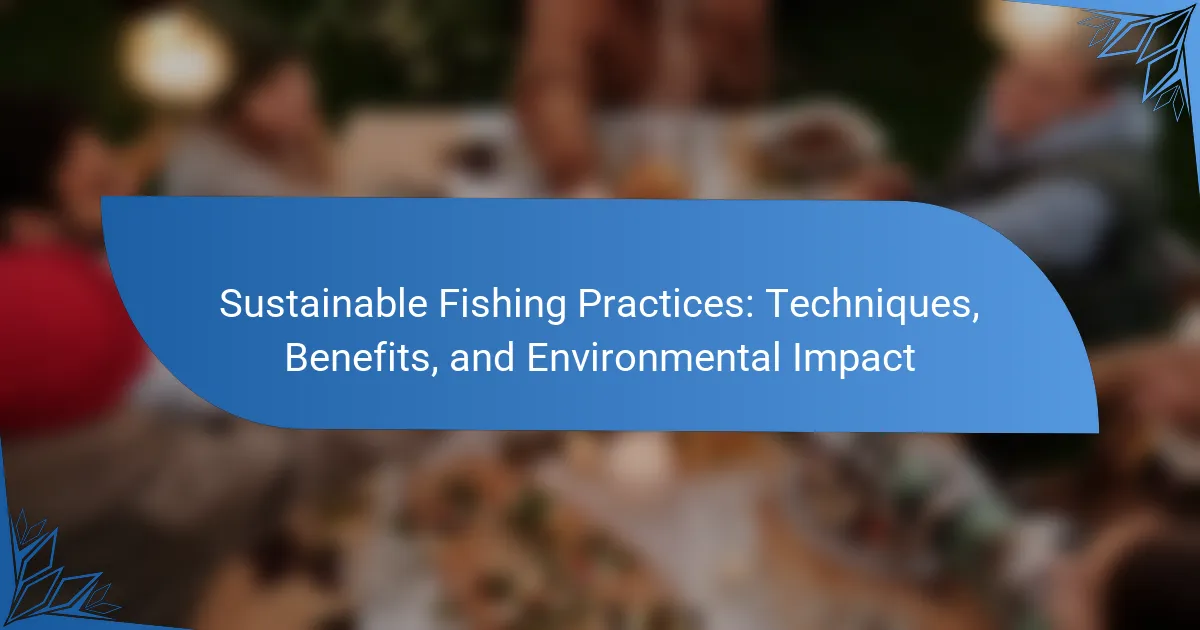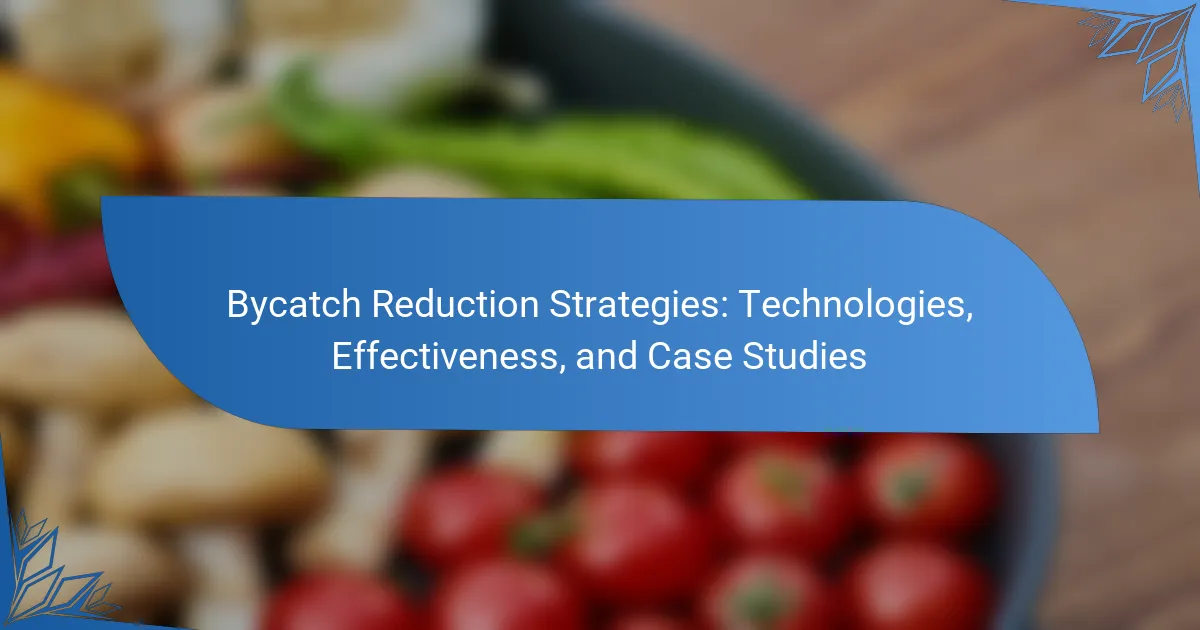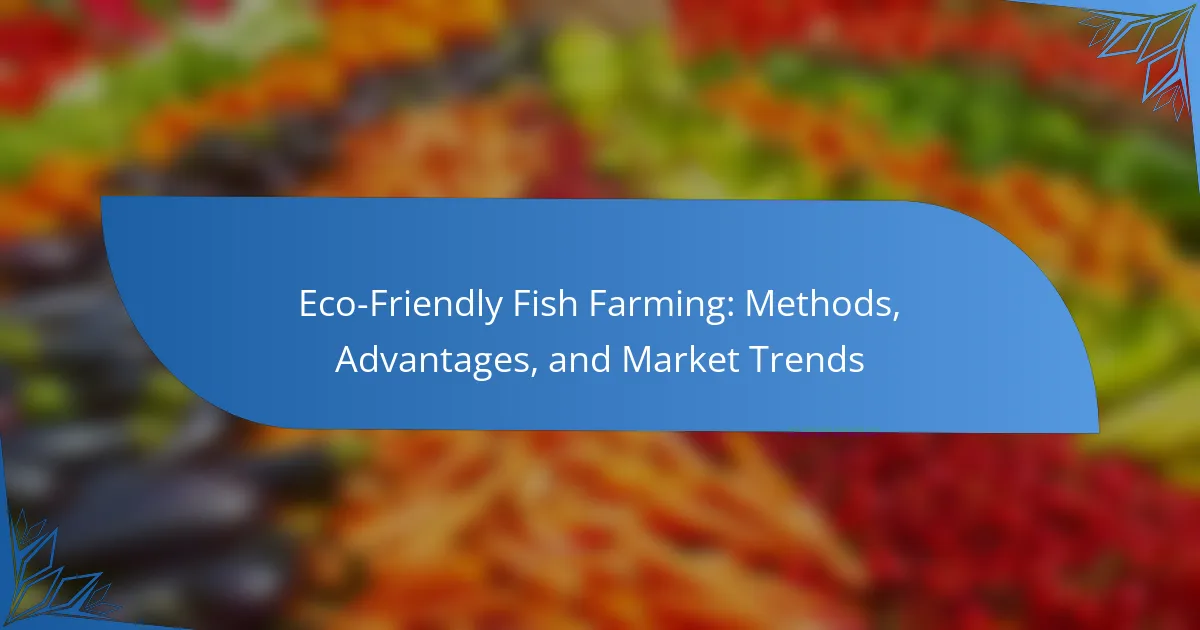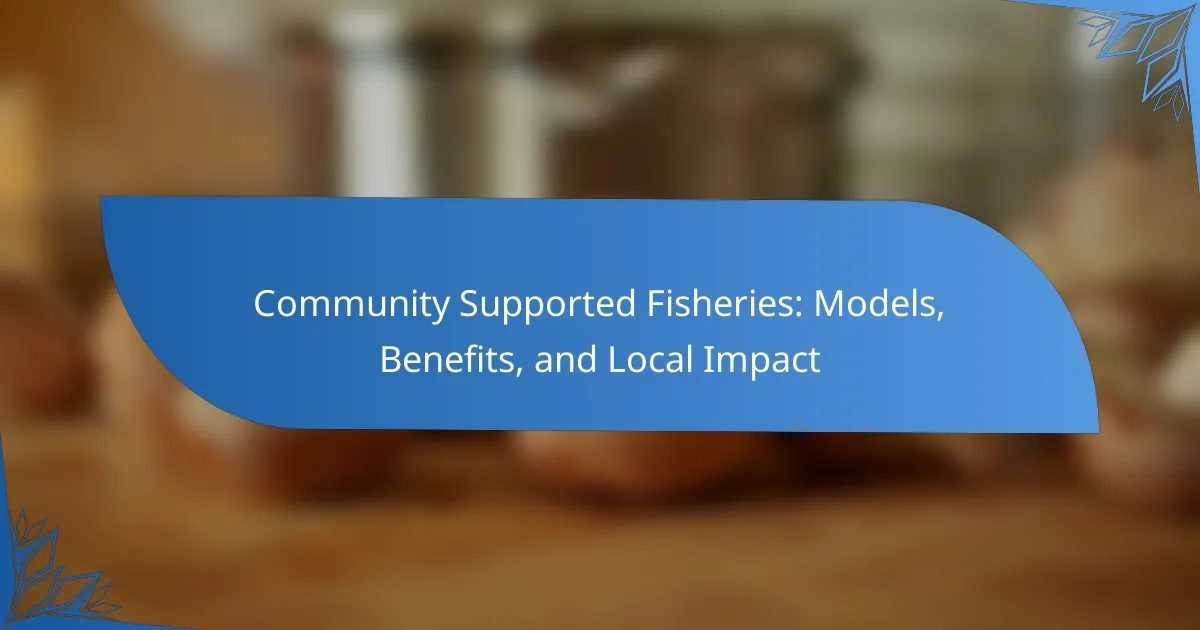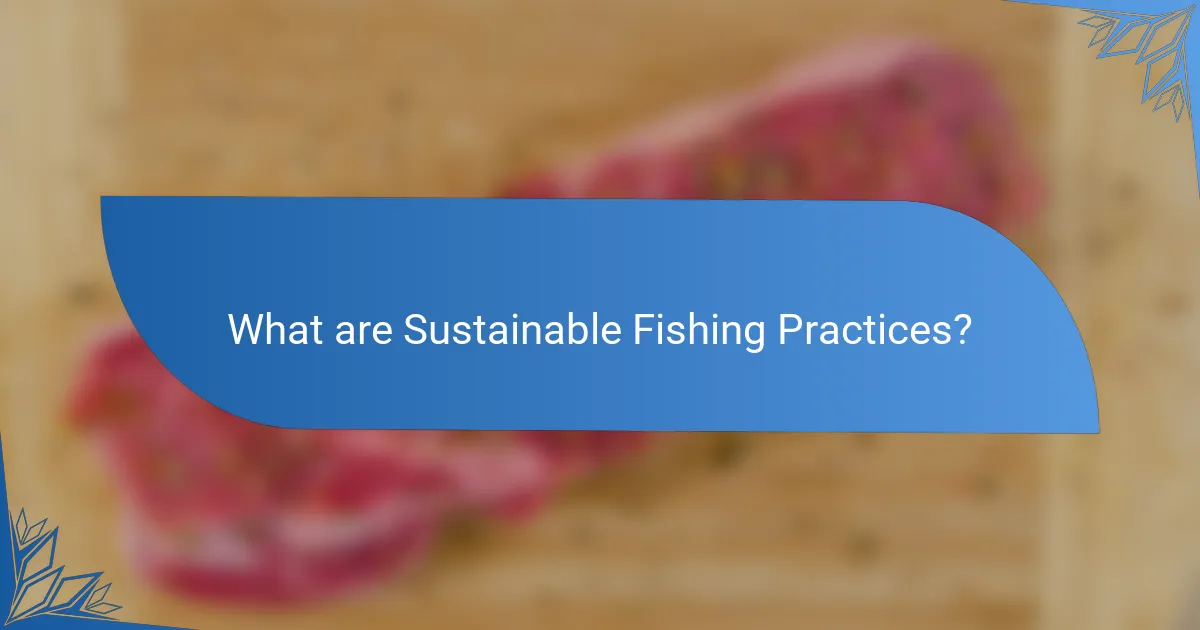
What are Sustainable Fishing Practices?
Sustainable fishing practices are methods that ensure fish populations remain healthy and ecosystems are preserved. These practices include techniques such as catch limits, selective fishing gear, and habitat protection. They aim to minimize environmental impact and prevent overfishing. For example, the use of nets that reduce bycatch protects non-target species. Research indicates that sustainable practices can lead to long-term economic benefits for fishing communities. The United Nations Food and Agriculture Organization states that sustainable fisheries enhance food security and livelihoods.
How do Sustainable Fishing Practices differ from traditional fishing methods?
Sustainable fishing practices prioritize long-term ecological balance, while traditional fishing methods often focus on short-term yield. Sustainable practices use techniques like selective fishing and quotas to preserve fish populations. These methods aim to reduce bycatch and protect marine habitats. In contrast, traditional methods may involve overfishing and destructive practices, leading to depletion of resources. Research indicates that sustainable practices can improve fish stocks and ecosystem health over time. For example, the Marine Stewardship Council reports that fisheries certified as sustainable have healthier fish populations. Thus, sustainable fishing contributes to environmental preservation, unlike many traditional methods that can harm marine ecosystems.
What are the key principles of Sustainable Fishing Practices?
The key principles of sustainable fishing practices include maintaining fish populations, minimizing environmental impact, and ensuring economic viability. Maintaining fish populations involves adhering to catch limits based on scientific assessments. This ensures that fish stocks can reproduce and sustain their numbers over time. Minimizing environmental impact includes using methods that reduce bycatch and habitat destruction. Techniques such as selective fishing gear can help achieve this goal. Ensuring economic viability means supporting the livelihoods of fishing communities while promoting responsible fishing. These principles align with guidelines set by organizations like the Marine Stewardship Council. Their standards help ensure that fishing practices do not compromise future generations’ ability to fish sustainably.
What role do regulations play in Sustainable Fishing Practices?
Regulations play a crucial role in sustainable fishing practices. They establish guidelines to prevent overfishing and protect marine ecosystems. Regulations limit catch sizes, specify fishing seasons, and define allowable fishing methods. These measures help maintain fish populations at sustainable levels. For instance, the Magnuson-Stevens Fishery Conservation and Management Act in the U.S. sets annual catch limits to ensure long-term sustainability. Compliance with regulations also promotes biodiversity by protecting vulnerable species. Effective enforcement of these regulations is essential for their success. Studies show that regions with strict fishing regulations see healthier fish stocks and improved ecosystem health.
Why are Sustainable Fishing Practices important for marine ecosystems?
Sustainable fishing practices are important for marine ecosystems because they help maintain biodiversity and ensure the health of fish populations. These practices reduce overfishing, which can lead to the collapse of fish stocks. Healthy fish populations support the entire marine food web, including predators and prey. Sustainable methods also minimize habitat destruction, preserving vital ecosystems like coral reefs and seagrasses. According to the Food and Agriculture Organization, unsustainable fishing threatens 34% of global fish stocks. By implementing sustainable practices, we can protect marine environments and promote long-term ecological balance.
How do Sustainable Fishing Practices contribute to biodiversity?
Sustainable fishing practices enhance biodiversity by protecting marine ecosystems and ensuring fish populations remain healthy. These practices reduce overfishing, which can lead to the collapse of fish stocks and the degradation of habitats. By using methods like selective gear and seasonal closures, sustainable fishing minimizes bycatch and allows non-target species to thrive. Research shows that marine protected areas, a component of sustainable practices, can increase species richness by up to 30%. Additionally, sustainable practices promote the conservation of critical habitats, such as coral reefs and mangroves, which support diverse marine life. Overall, these practices contribute to a balanced ecosystem, supporting both fish populations and the broader marine environment.
What impact do these practices have on fish populations?
Sustainable fishing practices positively impact fish populations. These practices help maintain healthy fish stocks and ecosystems. Techniques such as catch limits and seasonal closures prevent overfishing. They allow fish populations to regenerate and thrive. Research shows that areas with sustainable practices see a 20% increase in fish populations over five years. Additionally, selective fishing methods reduce bycatch, protecting non-target species. This approach enhances biodiversity and ecosystem stability. Overall, sustainable fishing promotes long-term viability for fish populations.
What are the main techniques used in Sustainable Fishing Practices?
The main techniques used in sustainable fishing practices include selective fishing gear, catch limits, and habitat protection. Selective fishing gear minimizes bycatch and targets specific species. This approach helps preserve non-target species and reduces ecosystem disruption. Catch limits are established based on scientific assessments to maintain fish populations. These limits ensure that fish stocks remain healthy and can reproduce effectively. Habitat protection involves safeguarding critical marine environments, such as coral reefs and spawning grounds. This technique supports biodiversity and the overall health of marine ecosystems. Together, these techniques contribute to the long-term viability of fish populations and marine habitats.
What is selective fishing and how does it work?
Selective fishing is a fishing method that targets specific species while minimizing the capture of non-target species. This technique works by using specialized gear and techniques designed to catch certain fish sizes or species. For example, nets with larger mesh sizes allow smaller fish to escape. Selective fishing reduces bycatch, which is the unintentional capture of non-target species. This practice helps maintain fish populations and supports sustainable fishing efforts. Studies show that selective fishing can lead to healthier marine ecosystems. By focusing on specific species, it allows for better management of fish stocks.
How does aquaculture contribute to sustainable fishing?
Aquaculture contributes to sustainable fishing by providing an alternative source of seafood that reduces pressure on wild fish populations. It allows for the controlled breeding and harvesting of fish, shellfish, and aquatic plants. This method can help replenish overfished species by ensuring a steady supply. According to the Food and Agriculture Organization (FAO), aquaculture accounted for 46% of global fish consumption in 2020. By cultivating fish in farmed environments, aquaculture can minimize bycatch and habitat destruction associated with traditional fishing methods. Sustainable aquaculture practices also promote responsible feed sourcing and waste management. These practices help maintain ecosystem balance and support local economies.
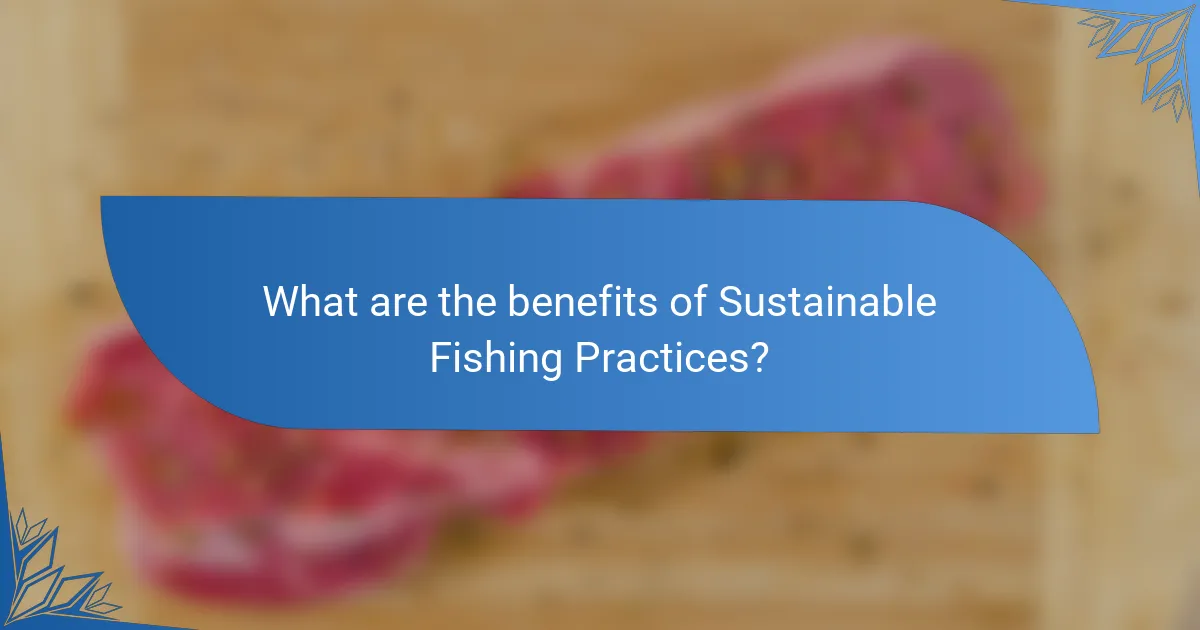
What are the benefits of Sustainable Fishing Practices?
Sustainable fishing practices provide numerous benefits. They help maintain fish populations at healthy levels. This prevents overfishing and ensures the long-term viability of marine ecosystems. Sustainable methods also protect biodiversity by minimizing habitat destruction. For instance, using selective gear reduces bycatch of non-target species. Additionally, sustainable fishing supports local economies by promoting responsible seafood sourcing. According to the Food and Agriculture Organization, sustainable practices can enhance food security by ensuring a stable supply of fish. Implementing these practices leads to healthier oceans, which benefits both the environment and human communities.
How do Sustainable Fishing Practices benefit the fishing industry?
Sustainable fishing practices benefit the fishing industry by ensuring long-term fish stocks and ecosystem health. These practices reduce overfishing, which can lead to stock depletion. Healthy fish populations contribute to stable supply chains. This stability can enhance profitability for fishers. Sustainable methods also improve market access. Consumers increasingly prefer sustainably sourced seafood. Certification programs like the Marine Stewardship Council boost brand reputation. Research shows that sustainable fisheries can yield higher economic returns over time.
What economic advantages do Sustainable Fishing Practices provide?
Sustainable fishing practices provide long-term economic benefits by ensuring fish populations remain healthy. Healthy fish stocks lead to consistent catches, which supports the livelihoods of fishermen. According to the Food and Agriculture Organization, sustainable practices can increase fishery revenues by up to 30%. Additionally, these practices promote biodiversity, enhancing ecosystem resilience. A resilient ecosystem can better withstand environmental changes, ultimately benefiting the fishing industry. Sustainable practices also attract eco-conscious consumers, potentially increasing market demand. This increased demand can lead to higher prices for sustainably sourced seafood. Overall, sustainable fishing practices create a stable economic environment for fishery stakeholders.
How do these practices enhance community resilience?
Sustainable fishing practices enhance community resilience by promoting ecological balance and ensuring long-term fish populations. These practices reduce overfishing, which helps maintain biodiversity in marine ecosystems. Healthy fish stocks contribute to food security for local communities. Sustainable methods also create economic stability by supporting local fisheries and reducing dependency on imported seafood. Additionally, these practices foster community engagement and cooperation, strengthening social ties. Research shows that communities utilizing sustainable fishing methods report increased resilience to environmental changes. A study by the World Wildlife Fund highlights that sustainable fisheries can lead to a 20% increase in community income over time.
What are the environmental benefits of Sustainable Fishing Practices?
Sustainable fishing practices provide significant environmental benefits. They help maintain fish populations at healthy levels. This prevents overfishing and allows ecosystems to thrive. Sustainable methods also minimize bycatch, protecting non-target species. Healthy marine ecosystems support biodiversity, which is crucial for resilience. Additionally, these practices reduce habitat destruction, preserving critical underwater environments. Studies indicate that sustainable fishing can enhance the recovery of depleted fish stocks. For example, the Marine Stewardship Council reports that certified fisheries show improved stock status.
How do these practices help in reducing overfishing?
Sustainable fishing practices help reduce overfishing by implementing measures that protect fish populations and their habitats. These practices include setting catch limits, which prevent the depletion of fish stocks. They also promote selective fishing techniques, minimizing bycatch and allowing non-target species to thrive. Additionally, sustainable practices involve habitat restoration, ensuring ecosystems remain healthy and productive. Research shows that areas with sustainable fishing practices can recover fish populations more effectively. For instance, a study by the World Wildlife Fund indicates that well-managed fisheries can increase fish biomass by 30% over time. Overall, these practices contribute to maintaining balanced marine ecosystems and ensuring long-term fish availability.
What role do Sustainable Fishing Practices play in habitat preservation?
Sustainable fishing practices play a crucial role in habitat preservation. These practices minimize environmental impact and protect marine ecosystems. By avoiding overfishing, they help maintain fish populations at sustainable levels. This balance supports the entire food web within the habitat. Techniques such as selective fishing reduce bycatch and protect non-target species. Additionally, sustainable practices often involve habitat restoration efforts. For example, the use of gear that minimizes damage to the seafloor helps preserve critical habitats like coral reefs. Research indicates that sustainable fishing can lead to healthier marine environments, promoting biodiversity. A study by the World Wildlife Fund highlights that sustainable practices can enhance ecosystem resilience.
How do Sustainable Fishing Practices contribute to food security?
Sustainable fishing practices enhance food security by ensuring the long-term availability of fish resources. These practices prevent overfishing, which can deplete fish populations and disrupt ecosystems. By maintaining fish stocks at sustainable levels, they support stable food supplies for communities reliant on fish as a primary protein source. According to the Food and Agriculture Organization (FAO), sustainable fisheries contribute to the livelihoods of over 200 million people globally. Additionally, these practices promote biodiversity, which is crucial for resilient ecosystems that can better withstand environmental changes. Sustainable fishing also encourages responsible management of aquatic resources, ensuring that future generations have access to the same food sources.
What is the relationship between sustainability and fish availability?
Sustainability directly influences fish availability. Sustainable fishing practices help maintain fish populations and their habitats. Overfishing depletes fish stocks and disrupts ecosystems. Research indicates that sustainable practices can increase fish biomass by up to 30%. Healthy ecosystems support diverse fish species and ensure long-term availability. Conservation efforts also contribute to restoring overfished areas. Therefore, sustainability is crucial for ensuring a stable supply of fish for future generations.
How can Sustainable Fishing Practices support local communities?
Sustainable fishing practices can support local communities by promoting economic stability and resource conservation. These practices ensure fish populations remain healthy, enabling consistent catches for local fishers. A study by the Food and Agriculture Organization (FAO) indicates that sustainable fisheries contribute significantly to local economies, providing jobs and income. Additionally, sustainable practices help maintain the ecosystem, which is vital for the long-term viability of fishing. This ecological balance supports other local industries, such as tourism, enhancing community resilience. By engaging in sustainable fishing, communities foster a sense of stewardship over their resources, promoting social cohesion and cultural identity.
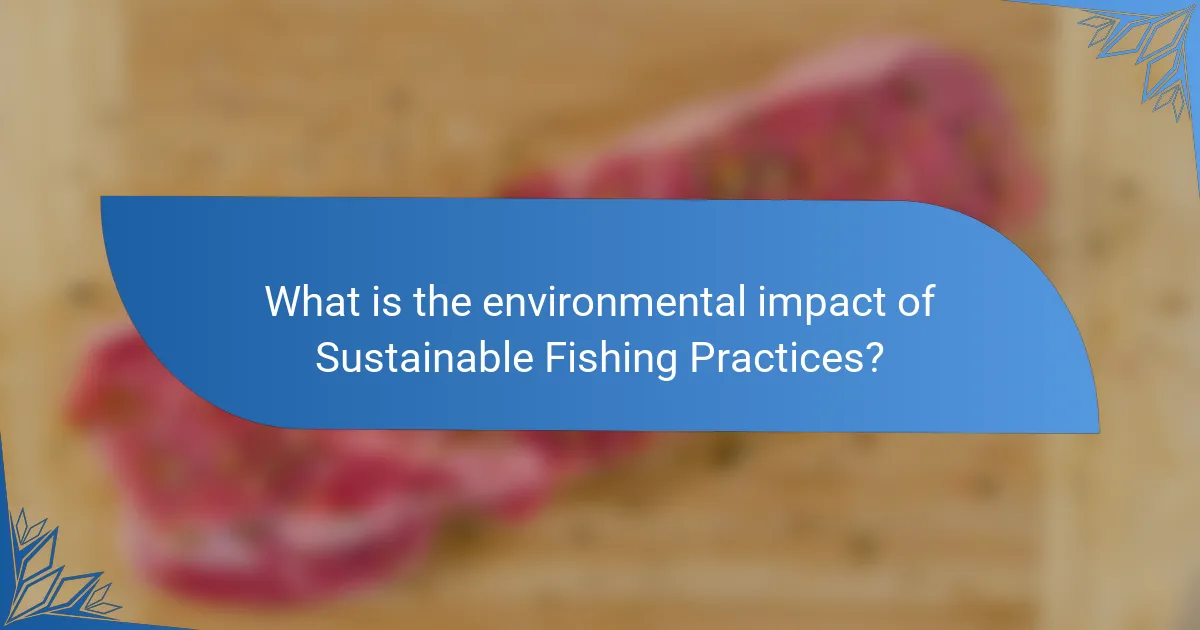
What is the environmental impact of Sustainable Fishing Practices?
Sustainable fishing practices have a positive environmental impact. They help maintain fish populations and prevent overfishing. These practices promote biodiversity by protecting various marine species. Sustainable methods reduce habitat destruction, preserving ecosystems. For example, selective fishing gear minimizes bycatch. This approach allows non-target species to thrive. Research shows that sustainable fisheries can recover populations within a few years. A study by the Food and Agriculture Organization highlights that sustainable practices lead to healthier oceans. Therefore, sustainable fishing is crucial for marine conservation.
How do Sustainable Fishing Practices mitigate climate change effects?
Sustainable fishing practices mitigate climate change effects by promoting the health of marine ecosystems. Healthy ecosystems absorb more carbon dioxide, reducing greenhouse gas levels. These practices include catch limits and selective fishing methods. They prevent overfishing, allowing fish populations to recover. A study by the World Wildlife Fund shows that sustainable fisheries can increase fish biomass by 50%. This increase contributes to greater carbon sequestration in ocean habitats. Additionally, sustainable practices reduce bycatch, protecting non-target species and maintaining biodiversity. Biodiversity enhances ecosystem resilience against climate change impacts. Thus, sustainable fishing practices play a crucial role in climate change mitigation.
What are the long-term ecological impacts of these practices?
Sustainable fishing practices lead to positive long-term ecological impacts. These practices help maintain fish populations at healthy levels. Overfishing is mitigated, allowing ecosystems to thrive. Biodiversity is preserved as habitats are less disturbed. Bycatch reduction techniques protect non-target species. This results in healthier marine ecosystems overall. Additionally, sustainable practices promote the recovery of overexploited species. Studies show that marine reserves enhance fish biomass and diversity. For instance, research by Roberts et al. (2001) demonstrated that marine protected areas can lead to a 600% increase in fish populations over time.
How do Sustainable Fishing Practices influence carbon footprints?
Sustainable fishing practices reduce carbon footprints by minimizing overfishing and habitat destruction. These practices often involve selective harvesting techniques that target specific species. This approach helps maintain biodiversity and ecosystem health. Healthier ecosystems can sequester more carbon, thus lowering overall carbon emissions. Additionally, sustainable practices often include using energy-efficient fishing methods. According to a study by the Food and Agriculture Organization, sustainable fisheries can reduce greenhouse gas emissions by up to 30%. This reduction is crucial in mitigating climate change impacts.
What challenges do Sustainable Fishing Practices face?
Sustainable fishing practices face several significant challenges. Overfishing remains a primary issue, as many fish populations are depleted beyond recovery. Habitat destruction from fishing methods, such as trawling, further exacerbates the problem. Climate change impacts marine ecosystems, altering fish migration patterns and breeding cycles. Additionally, illegal, unreported, and unregulated (IUU) fishing undermines sustainable efforts by depleting resources without oversight. Economic pressures often lead fishermen to prioritize short-term gains over long-term sustainability. Awareness and education gaps also exist, hindering the adoption of sustainable practices among communities. Lastly, policy enforcement is often weak, leading to non-compliance with sustainability regulations.
What are the economic barriers to adopting Sustainable Fishing Practices?
Economic barriers to adopting sustainable fishing practices include high initial investment costs and limited access to financing. Fishermen may face substantial expenses for new equipment and technology. These costs can deter small-scale fishers from transitioning to sustainable methods. Additionally, market demand for sustainably sourced fish is often lower, impacting profitability. Regulatory compliance can also impose financial burdens on fishers. The lack of government incentives further complicates the situation. Studies show that regions with financial support see higher adoption rates of sustainable practices. For example, the Food and Agriculture Organization reported that financial assistance can enhance sustainability efforts in fisheries.
How do cultural attitudes affect Sustainable Fishing Practices?
Cultural attitudes significantly influence sustainable fishing practices. Societies that prioritize environmental stewardship often adopt more sustainable methods. For example, communities with strong traditions of conservation may implement local regulations to protect fish populations. Conversely, cultures that emphasize short-term economic gains may overfish, leading to depletion of resources. Research by the Food and Agriculture Organization indicates that cultural beliefs shape fishing techniques and resource management. In regions where fishing is integral to identity, sustainable practices are more likely to be embraced. This connection between culture and sustainability highlights the need for culturally sensitive approaches in fisheries management.
What practical steps can be taken to promote Sustainable Fishing Practices?
Implementing sustainable fishing practices involves several practical steps. First, establishing catch limits helps prevent overfishing. These limits should be based on scientific assessments of fish populations. Second, promoting the use of selective fishing gear reduces bycatch. This gear targets specific species and minimizes harm to other marine life. Third, encouraging the establishment of marine protected areas (MPAs) allows ecosystems to recover. MPAs help sustain fish populations and biodiversity. Fourth, supporting community-based fisheries management empowers local fishers. This approach ensures that local knowledge informs sustainable practices. Fifth, advocating for sustainable seafood certifications guides consumers towards responsible choices. Certifications like the Marine Stewardship Council (MSC) ensure products meet sustainability standards. Lastly, raising public awareness about the importance of sustainable fishing fosters community support. Education campaigns can highlight the ecological impacts of fishing practices. These steps collectively promote the health of marine ecosystems and ensure long-term fishing viability.
How can consumers support Sustainable Fishing Practices?
Consumers can support sustainable fishing practices by choosing seafood certified by reputable organizations. These certifications ensure that the seafood is sourced from environmentally responsible fisheries. Consumers should also avoid species that are overfished or caught using harmful methods. Research indicates that over 90% of global fish stocks are either fully exploited or overfished. Additionally, consumers can reduce demand for unsustainable seafood by opting for local and seasonal fish. Buying from local fish markets often supports sustainable practices. Educating themselves about sustainable seafood choices empowers consumers to make informed decisions. By advocating for policies that protect marine ecosystems, consumers can further influence sustainable fishing practices.
What role do education and awareness play in fostering Sustainable Fishing Practices?
Education and awareness are crucial in fostering sustainable fishing practices. They equip fishers and communities with knowledge about sustainable methods. Understanding the impact of overfishing helps in making informed decisions. Awareness campaigns can lead to better compliance with regulations. Studies show that educated fishers adopt practices that protect marine ecosystems. For example, the Marine Stewardship Council reported that certified fisheries practice better sustainability. Increased awareness can also drive consumer demand for sustainably sourced seafood. This, in turn, influences fishing practices positively. Overall, education and awareness create a culture of sustainability in fishing.
Sustainable fishing practices are methods designed to maintain healthy fish populations and preserve marine ecosystems. This article explores various techniques, including selective fishing gear, catch limits, and habitat protection, while highlighting their importance in reducing overfishing and promoting biodiversity. The benefits of these practices extend to economic stability for fishing communities and food security for local populations. Additionally, the article discusses the environmental impact of sustainable fishing, emphasizing its role in mitigating climate change and enhancing ecosystem resilience. Finally, it addresses the challenges and practical steps necessary for promoting sustainable fishing practices, including consumer support and education.
